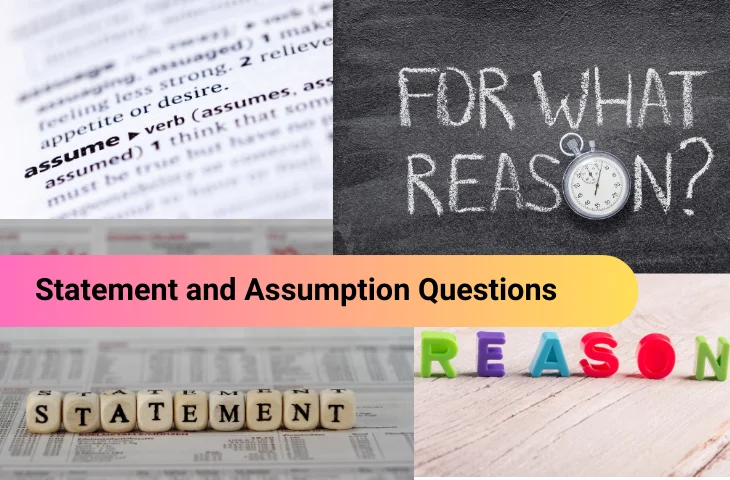Statement and Assumption is a key reasoning topic asked in almost every competitive exam including SSC, Banking, RRB, and State PSCs. In these questions, a statement is provided, and candidates must identify which assumptions are logically implicit in it. In this blog, we have provided the definition, importance, short notes, formulas, tricks, solved examples from 2024–25 exams, and more.
What Is Statement and Assumption in Reasoning?
In Statement and Assumption questions, you are given a statement followed by possible assumptions. An assumption is something that is implicitly taken for granted in the statement but not explicitly mentioned.
- Why it appears in exams?
These questions test logical thinking, ability to read between the lines, and decision-making skills. - Skills required:
Logical interpretation, critical thinking, identifying hidden meanings, and quick elimination of options.
Why Is Statement and Assumption Important in Competitive Exams?
Statement and Assumption questions may look simple but often test deep reasoning ability. Exams use them to check whether candidates can analyze implications beyond the surface meaning.
| Exam | No. of Questions | Difficulty |
| SSC CGL / CHSL | 1–2 | Easy |
| IBPS PO / SBI PO | 1–2 | Moderate |
| RRB NTPC / Group D | 1 | Easy |
| State PSC / Police | 1–2 | Moderate |
Get the details about the upcoming government exams you can apply for
Statement and Assumption Reasoning Short Notes
Some of the terms related to the topic statement and assumption are as follows:
| Term | Meaning |
| Statement | A given sentence or claim |
| Assumption | A hidden belief or precondition |
| Explicit Fact | Directly mentioned in the statement |
| Implicit Assumption | Understood but not directly written |
| Valid Assumption | Logically follows from the statement |
| Invalid Assumption | Cannot be concluded logically |
Quick Revision Summary
Some of the most used concepts for last-minute revision are as follows:
| Concept | Explanation |
| Statement | The given sentence under consideration |
| Assumption | Belief that must be true for statement to hold |
| Valid Assumption | Logically linked to the statement |
| Invalid Assumption | Not supported by the statement |
| Explicit Fact | Clearly mentioned in statement |
| Implicit Meaning | Hidden idea that supports the statement |
What Are the Types of Statement and Assumption Questions in Reasoning?
Types of Statement and Assumption Questions being asked in the exam are as follows:
1) Public Messages: Ads, Notices, Appeals
Hallmark: A message aimed at the public asking them to do/avoid something.
Typical valid assumption: The audience can see/understand the message and may change behaviour.
Trap: Assuming guaranteed compliance or universal reach.
Fresh example:
Statement: “Use the metro on festival days to keep roads decongested.”
Implicit assumption: Many commuters are able and willing to switch to metro on those days.
Invalid leap: “Everyone owns a metro pass.”
2) Cause–Effect Assertions
Hallmark: A claim that X is happening because of Y, or that Y will lead to Z.
Typical valid assumption: The cause and effect are connected strongly enough to matter in this context.
Trap: Confusing coincidence with causation.
Fresh example:
Statement: “Online grocery orders spiked after the heatwave.”
Implicit assumption: Heat discourages outdoor shopping, nudging people online.
Invalid leap: “No other factor (discounts, holidays) played any role.”
Check out 100 Reasoning Questions with Solution for IBPS RRB
3) Recommendations / Course of Action
Hallmark: Advice, suggestion, or a proposed remedy.
Typical valid assumption: The action is feasible and likely to address the problem.
Trap: Assuming resources, permissions, or perfect execution exist.
Fresh example:
Statement: “Schedule weekend mock tests to raise prelims scores.”
Implicit assumption: Regular testing improves performance for these candidates.
Invalid leap: “Mocks alone guarantee selection.”
4) Existence / Feasibility of a Condition
Hallmark: A proposal or claim that presumes something/someone exists or is available.
Typical valid assumption: The subject or condition actually exists (or can exist).
Trap: Assuming universal availability or scale.
Fresh example:
Statement: “Launch evening classes for working aspirants.”
Implicit assumption: There are enough working aspirants who would attend.
Invalid leap: “All working aspirants prefer evenings.”
5) Time-Anchored Claims (Past/Present/Future)
Hallmark: Mentions policy effects, trends, or expectations across time.
Typical valid assumption: The current/expected context allows the predicted impact.
Trap: Dragging in unrelated past success/failure or assuming permanence.
Fresh example:
Statement: “The revised pattern will improve question quality next year.”
Implicit assumption: The revision targets known gaps affecting quality.
Invalid leap: “The earlier pattern had no merits at all.”
6) Policy / Regulatory Announcements
Statement: “Cap interchange fees to make digital payments cheaper.”
Assumes: Lower fees will be passed on to users (and adoption will rise).
Trap: Assuming banks/PSPs will not offset via other charges.
7) Conditional (If–Then) & Eligibility Framing
Statement: “If attendance falls below 70%, bar the candidate from the lab.”
Assumes: Attendance is a meaningful proxy for lab readiness.
Trap: Treating the condition as both necessary and sufficient without evidence.
8) Comparative / Benchmark Claims
Statement: “Regional newspapers are more trusted than national dailies.”
Assumes: The comparison metric (trust) is measurable and relevant here.
Trap: Extending a local survey to the entire population.
9) Appeal to Authority / Expert Citation
Statement: “As per the health council, screen adults annually.”
Assumes: The council is credible and its guidance fits this population.
Trap: Blindly accepting authority without context.
10) Quantified or Proportional Claims
Statement: “Most first-time test takers struggle with DI sets.”
Assumes: A sizeable majority actually faces difficulty.
Trap: Reading “most” as “all.”
11) Goal–Means Framing
Statement: “To cut evaluation time, adopt OMR scanning.”
Assumes: OMR scanning is faster and workable for this exam.
Trap: Ignoring setup costs, training, or error rates.
Also Solve Statement and Assumption Questions Based on RRB NTPC
12) Resource / Constraint Based
Statement: “Limit batch size to 40 to improve interaction.”
Assumes: Smaller groups lead to more interaction here.
Trap: Assuming the same effect regardless of faculty/format.
13) Hypothetical / Counterfactual
Statement: “Had we started earlier, the campaign would have succeeded.”
Assumes: Early start is a decisive success factor.
Trap: Overlooking other bottlenecks (budget, messaging).
14) Multi-Statement / Layered Sets
Statement(s): Two or more claims that jointly support a proposal.
Assumes: Each link in the chain holds (A-B, B-C).
Trap: One weak link breaks the overall assumption.
Statement and Assumption Formulas for Reasoning
While there are no mathematical formulas, reasoning “templates” act as shortcuts:
- If a statement suggests an action, the assumption is that action is possible.
- If a statement suggests a problem, the assumption is that the problem exists.
- If a statement provides a solution, the assumption is that the solution is effective.
- If a statement is advice, the assumption is that following it is beneficial.
Statement and Assumption Tricks for SSC CGL and Other Exams
Follow these strategies to solve questions quickly:
- Identify the core idea of the statement.
- Ask: “What must be true for this statement to make sense?”
- Eliminate assumptions that are not directly related.
- Do not assume things outside the scope of the statement.
- Remember: Assumptions are about what is believed, not what is proven.
Practice all questions based on Logical Reasoning
How to Approach Statement and Assumption Questions
When solving Statement and Assumption questions, the key is to understand the hidden belief that makes the statement meaningful. By following some simple steps, you can avoid common traps and pick the right answer.
- Author’s Point of View: Always think like the person making the statement and ask what they believe to be true.
- Negation Test: Reverse the assumption – if the statement collapses, the assumption is valid.
- Stick to Given Info: Use only the data in the statement, avoid bringing in outside facts.
- Avoid Extreme Wording: Assumptions with “all, always, every, only” are usually invalid.
- Check Relevance: Assumptions must directly support the statement, not contradict or add unrelated ideas.
Solved Statement and Assumption Questions from 2024–25 Exams
Q1. SSC CGL 2024 (Memory-Based, Tier 1 Shift 2)
Statement: “Government should make yoga mandatory in schools.”
Assumptions:
- Yoga is beneficial for students.
- All schools have yoga teachers.
Answer: Only Assumption 1 is valid.
Explanation: The statement assumes yoga is useful. It doesn’t assume that every school already has yoga teachers.
Take a free SBI PO Previous Year Paper Test now!
Q2. IBPS PO 2024
Statement: “Private vehicles should be banned in city areas.”
Assumptions:
- Traffic congestion can be reduced this way.
- People will follow the rule.
Answer: Only Assumption 1 is valid.
Q3. RRB NTPC 2024 (Memory-Based)
Statement: “Coaching institutes should be regulated by the government.”
Assumptions:
- Some coaching institutes exploit students.
- Students cannot study without coaching.
Answer: Only Assumption 1 is valid.
Check out all the details about Analytical Reasoning
Statement and Assumption Concepts for Bank Exams
Bank exams like IBPS PO and SBI PO often ask tricky versions:
- Coded assumptions in abstract language.
- Situational assumptions involving policies, banking, or economy.
Example:
Statement: “RBI should cut repo rates to boost economy.”
Assumption: Cutting repo rate will increase growth.
Common Mistakes to Avoid while Solving Statement and Assumption
While solving questions based on the topic Statement and Assumption, aspirants must keep these details in mind to avoid mistakes while solving such types of questions:
- Assuming outside knowledge – Stick to the statement only.
- Treating facts as assumptions – Facts are explicit, assumptions are implicit.
- Overgeneralizing – Don’t assume beyond what’s logically implied.
- Ignoring the scope – Assumptions must be linked directly to the statement.
- Confusing conclusion with assumption – Assumption is the base, conclusion is the result.
Related Reasoning Topics to Explore
| Topics | Topics |
| Blood Relation Concepts | Floor Based Puzzle Short Tricks |
| Clock Reasoning Concepts | Puzzle Reasoning Questions |
| Calendar Reasoning Strategies | Alphanumeric Series Patterns |
Aspirants, now you have a clear understanding of how to practice and solve Statement and Assumption questions effectively. You can also enroll in Oliveboard Courses and learn from experienced faculty members to strengthen your preparation before appearing for the next competitive exam.
FAQs
Ans. They test a candidate’s logical ability, critical thinking, and decision-making skills.
Ans. Types include advertisements, notices, cause-and-effect, course of action, and existence/non-existence assumptions.
Ans. Yes, many questions allow multiple assumptions if both logically support the statement.
Ans. An assumption is an unstated belief behind a statement, while an inference is a conclusion drawn from it.
Ans. Think like the author of the statement and not from your personal perspective.
- PNB LBO Syllabus and Exam Pattern 2025, Check Details
- PNB LBO Salary 2025, In Hand Salary, Perks, and Allowances
- Most Repeated Quantitative Aptitude Questions for SSC CHSL Tier 2
- Bank of Baroda LBO Group Discussion, Topic List, Complete Guide
- Bank of Baroda LBO LPT, State-wise Languages & Full Details
- Bank of Baroda LBO Interview Questions and Answers, Download FREE PDF

Hi, I’m Aditi. I work as a Content Writer at Oliveboard, where I have been simplifying exam-related content for the past 4 years. I create clear and easy-to-understand guides for JAIIB, CAIIB, and UGC exams. My work includes breaking down notifications, admit cards, and exam updates, as well as preparing study plans and subject-wise strategies.
My goal is to support working professionals in managing their exam preparation alongside a full-time job and to help them achieve career growth.
